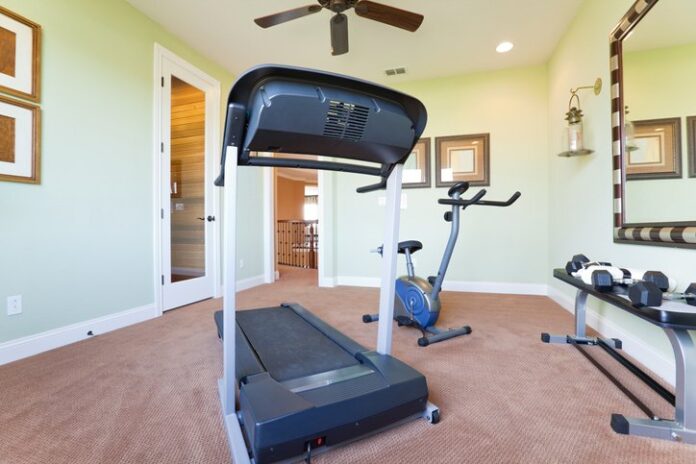[ad_1]

A few years back, we probably all had one, but it was rarely used. A dusty old treadmill, a few rusty dumbbells, and maybe even a ThighMaster or some VHS workout tapes scattered around the room. The home gym wasn’t really a thing with so many fitness clubs and workout groups. But then the pandemic hit . . . clubs closed, and workout groups were splintered. We all had to return to working out at home, and that dark dusty home gym got called back into the spotlight! Despite recent re-openings, many of us chose to stick with the safety of our own space. Let’s work on that workout room!
Once you’ve cleared the cobwebs and readied the fitness equipment, you need to consider how to illuminate the space. So many factors come into play here . . . Is there a natural light source like a window or a sky light? Do you work out before dawn or after sunset? Are you a high-energy HIIT enthusiast or a meditative yogi? Each of these determinations can greatly influence your lighting choices.
If your home gym has a window or a skylight, and you work out during daytime hours, this may be all the light you need. Natural daylight is considered energizing and can help propel you through those midday push-ups. There are, however, situations where you can have too much natural light streaming through that window, creating an unwanted hot spot of sunshine on your weight bench or causing a nasty glare on your Peloton screen. So, you may still have to think about supplemental lighting if you must narrow the blinds to the great outdoors. And of course, if you exercise pre-dawn or post-sunset, windows won’t help.
In addition to the natural light limitation of early morning or later evening workout sessions, the space where many of us have relegated our home gym is often the garage or basement–no natural light at all. Making sure these spaces are adequately lit for safety and comfort is essential. With lower ceilings and dark corners, ample recessed lighting or LED downlights are great choices. Not only will those fixtures supply sufficient and even illumination, but there is also zero risk that you will knock into a hanging fixture during an enthusiastic aerobic session!

Now that you’ve got your recessed cans mapped out, it’s time to think about the mood and type of exercise that will dominate this space. The color of light can most definitely enhance different types of activities. The lighting guide on 1000Bulbs.com can help you visualize your needs. Bright, cool light bulbs, measuring 4000–6000 on the Kelvin scale are conducive to many high-energy activities like running, cross-training, Zumba, and cycling. Be mindful of screen-based activities and make sure the light isn’t too intense to compromise the visibility of instructional videos.
For lower intensity workouts like yoga, Pilates, Tai Chi, or even stretching and meditation, you might opt for a warmer, more soothing color of light, with bulbs measuring lower on the Kelvin scale around 2700–3000. If, like the many other spaces in our homes, your home gym will serve multiple types of exercise, get creative with layering options using cooler bulbs in your overhead recessed lights and warmer bulbs in wall sconces, track lighting, undercabinet lighting, or even experiment with installing some tape or rope lighting. Further customize light levels by employing compatible dimmer controls. Everyone in your healthy household will be motivated by being able to set up their own lighting scheme.
You’re working hard to stay in shape, so make sure your workout space is fit for the task! Get your questions answered today by talking with a knowledgeable 1000Bulbs lighting expert at 1-800-624-4488 or try the convenient chat feature at the bottom right corner of our web pages.
[ad_2]
blog.1000bulbs.com










